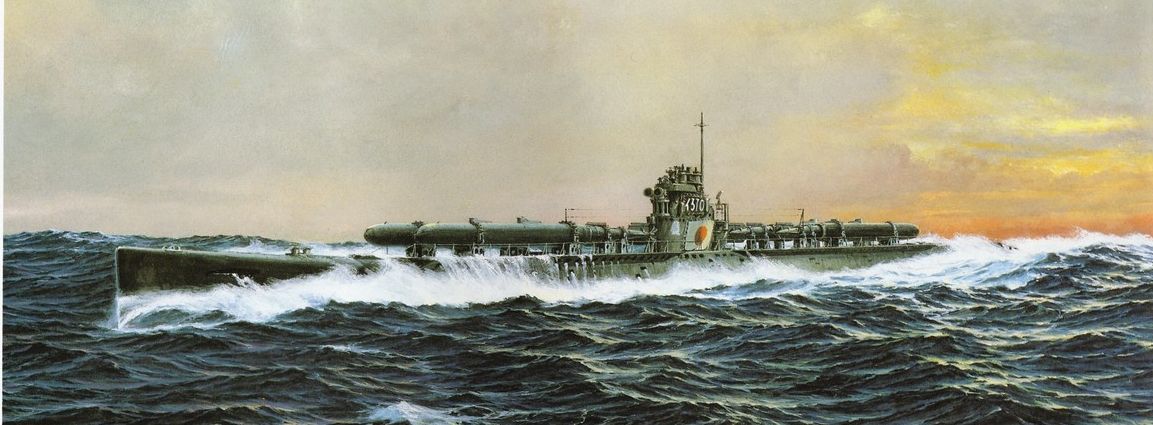SENSUIKAN!
 (Type D1 submarine by Takeshi Yuki)
(Type D1 submarine by Takeshi Yuki)
IJN Submarine I-370: Tabular Record of
Movement
© 2008-2014 Bob Hackett & Sander Kingsepp
Revision 2
4 December 1943:
Kobe. Laid down at Mitsubishi Kobe Yard as a Type D1 transport submarine No. 5470.
26 May 1944:
Launched and numbered I-370.
4 September 1944:
I-370 is completed, commissioned in the IJN and attached to Sasebo Naval District. Lt (LtCdr, posthumously) Fujikawa Susumu (66) is the CO. Assigned to SubRon 11 for working-up.
2 December 1944:
A special conference of more than 200 staff officers and specialists is held aboard Sixth Fleet's flagship, TSUKUSHI MARU to evaluate the results of the first kaiten ("Kikusui") mission to Ulithi. The staff considers reports and post-attack photo reconnaissance and concludes erroneously that three aircraft carriers and two battleships were sunk in the attack.
January 1945:
I-370 and I-368 are converted to "kaiten" (heavens shaker) carriers able to carry five human-torpedoes. Their deck guns are removed and Type 22 surface search radars are installed.
10 January 1945:
I-370 and I-368 participate in simulated kaiten attacks on towed targets in the Inland Sea that last for 15 days.
19 February 1945: American Operation "Detachment" - The Invasion of Iwo-Jima:
Vice Admiral (later Admiral) Raymond A. Spruance's Fifth Fleet of over 450 ships, lands the 54th Amphibious Corps (3rd, 4th, 5th Marine Divisions) who later capture the island and its vital airfields from LtGen Kuribayashi Tadamichi's defenders.
21 February 1945: The Third Kaiten Mission:
I-370 is in the "Chihaya" group with I-44 and I-368. The mission calls for the group to launch their kaiten at anchored American shipping off Iwo Jima. I-370 departs Hikari for Iwo Jima with five kaiten aboard (pilots Ens Okazaki Itaru (a former kaiten instructor from Hikari), Ichikawa Takatsugu, Tanaka Jiro, FPO2C Urasa Noboru, Kumada Koichi). She is expected to attack the American fleet five days after departure.
26 February 1945:
Shortly after sunrise, I-370 is running on the surface. LtCdr Fujikawa prepares to launch all of his Kaitens at nine empty American transports that departed Iwo for Saipan. Just then, I-370 is picked up on radar by LtCdr H. Huffman's USS FINNEGAN (DE-307). Huffman detaches from the escort screen and closes on the submarine. Eight minutes after being spotted, Fujikawa crash dives and breaks contact.
At 0659, FINNEGAN reacquires the submarine by sonar. The first ahead-thrown Mark 10 "hedgehog" projector charge attack fails. Huffman drops 13 deep-set depth charges and then fires a new series of hedgehog charges. Around 1000, 13 depth charges set to medium depth are released. Five minutes later a deep rumbling sound is heard and many air bubbles rise to the surface, followed by a lesser explosion. Fuel oil later covers an area 4 miles long and 2 wide at 22-44N, 141-26E.
FINNEGAN sinks I-370 with her crew of 79 and five kaiten pilots. I-370 is the first loss of the Chihaya group and the first cargo sub converted to carry kaiten to be lost.
6 March 1945:
I-370 and I-368 are recalled from the Iwo Jima area.
14 March 1945:
Presumed lost off Iwo Jima.
10 April 1945:
Removed from the Navy List.
Authors' Note:
Special thanks go to Dr. Higuchi Tatsuhiro of Japan.
– Bob Hackett and Sander Kingsepp.
Back to Submarine
Page





